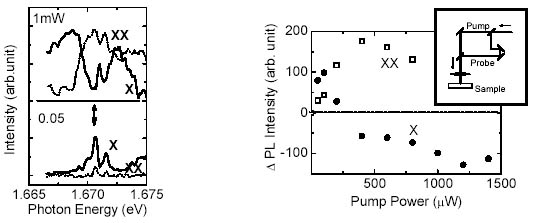Hideki Gotoh and Hidehiko Kamada
Optical Science Laboratory
Quantum dots have been attracting much attention because of their distinctive exciton-biexciton physics and important contribution to quantum information processes. In quantum dots, excitons and biexcitons (combined two excitons) stably exist due to the confinement effects in nanometer-scale structures. The stable excitons can induce coherent interactions with biexcitons. These coherent interactions provide quantum correlation effects as well as strong nonlinear optical effects like electromagnetically induced transparency (EIT), which are very useful in quantum information processing and conventional optical devices.
We found the strong optical nonlinearity in exciton absorption in zero-dimensional InGaAs quantum dots by using single-dot photoluminescence excitation (PLE) spectroscopy. This nonlinearity was caused by a coherent interaction between an exciton (X) and a biexciton (XX) [1, 2].
Figure 1 shows PLE spectra of X and XX for different excitation intensities.
PLEs correspond to absorption spectra. With a low excitation, peak-shaped
spectra can be seen in X and XX. With a high excitation, XX PLE spectrum
exhibits usual peak-shaped with a broadened linewidth. In contrast, the
X PLE has an unusual spectral shape with dip-shaped structure. The PLE
almost disappears at the exciton resonance. A large coherent effect between
X and XX yielded this unusual PLE. These coherent effects can be interpreted
in terms of EIT. To examine the coherent effects for optical nonlinearities,
we performed a pump and probe measurement. PL signals from an X and a XX
were detected with two beams through an interferometer. Figure 2 shows
the X and XX PL intensities as a function of excitation intensity. The
XX PL increases with pump power and saturates above 300 µW. In contrast,
the X PL increases up to 100 µW and decreases with pump power. This
decreasing region reflects large coherent effects between the X and XX
states. Our results reveal that an EIT-like optical nonlinearity is achieved
by the coherent interaction.
Our results constitute an important milestone for the quantum computing and will assist the development of novel optical device functions.
[1] H. Gotoh et al., Phys. Rev. B71 (2005) 195334.
[2] H. Gotoh et al., Appl. Phys. Lett. 87 (2005) 102101.
 |
||||||
|
|
|||||